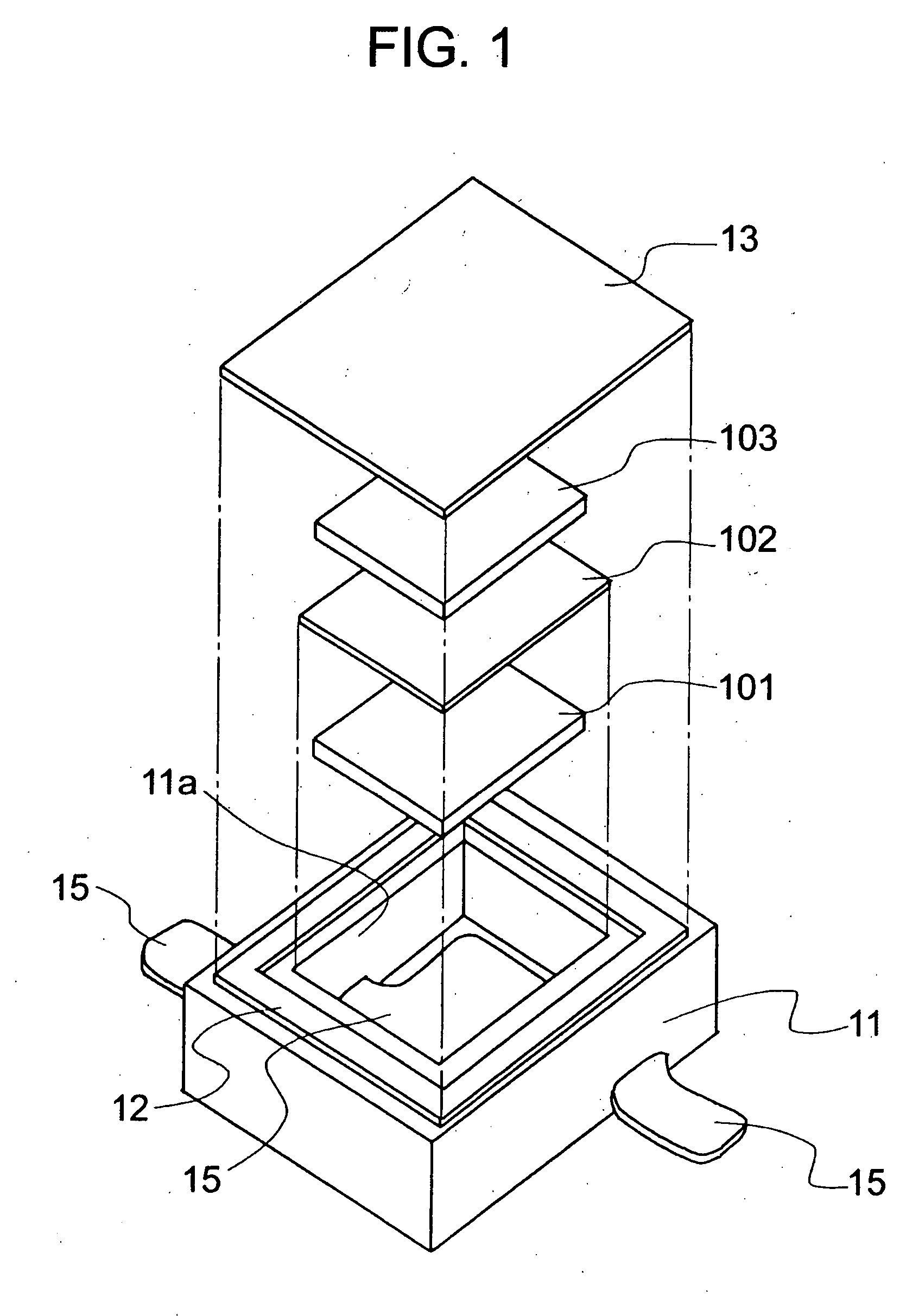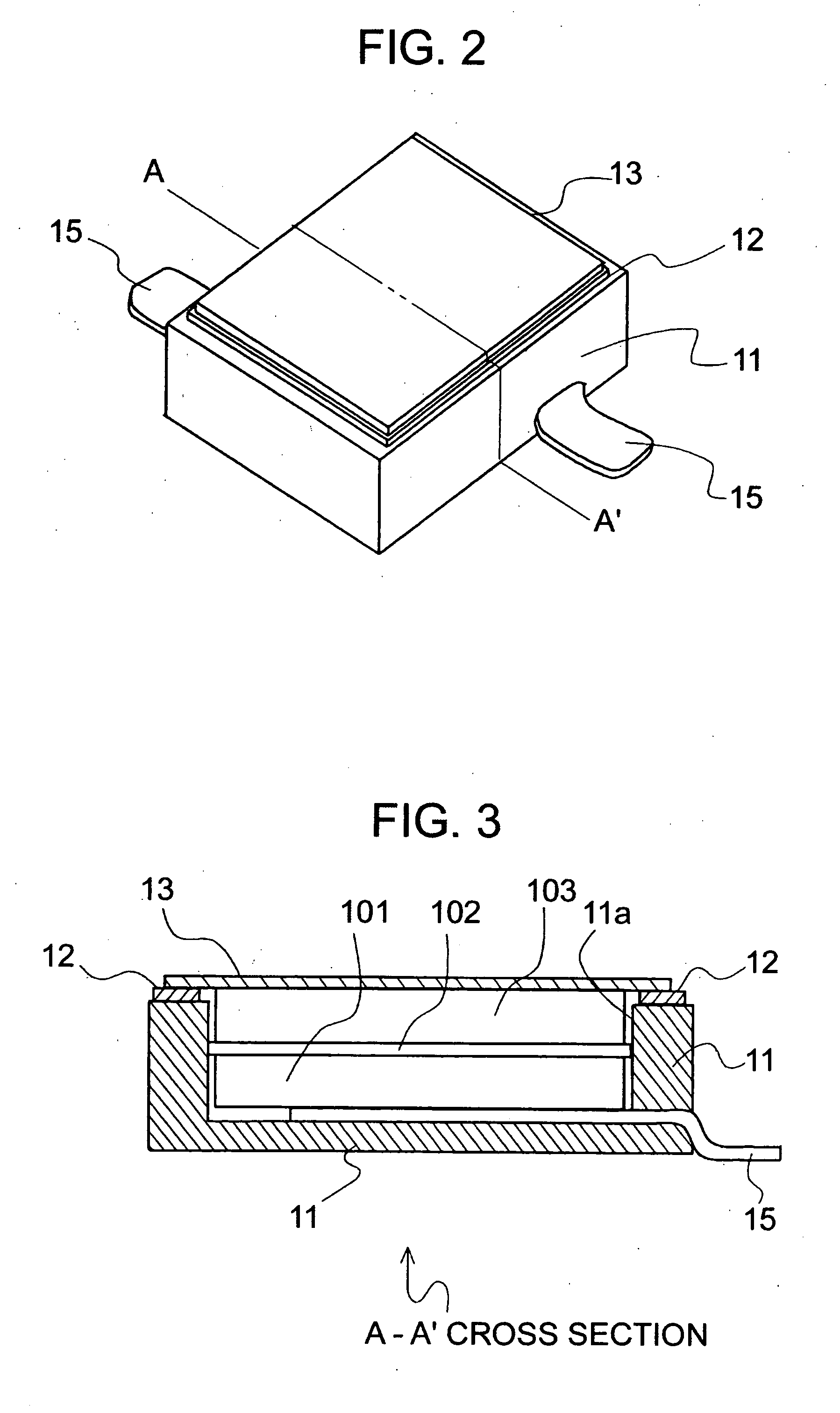Electrochemical cell and fabrication method of the same
- Summary
- Abstract
- Description
- Claims
- Application Information
AI Technical Summary
Benefits of technology
Problems solved by technology
Method used
Image
Examples
example 1
[0095]FIG. 1 shows a schematic diagram illustrating an electrochemical cell according to the invention. FIG. 2 shows an outside diagram illustrating the electrochemical cell according to the invention. FIG. 3 shows a cross-sectional view illustrating the electrochemical cell according to the invention.
[0096] In this example, an epoxy was used for a base member 11, and 18 Cr-12 Ni—Mo—Cu steel of stainless steel was used for a conductive terminal 15. Tin was plated over the portions where the conductive terminal 15 was extended to the outer wall of the base member 11 for facilitating solder joint to a mounting substrate. 42 Ni-Fe alloy was used for a frame member 12 and a cover member 13. An active material was prepared by kneading carbon black as a conductive material and PTFE as a binder with activated carbon commercially available. The kneaded product was rolled by roll press to form into a sheet, and it was cut to form a positive electrode active material 101 and a negative elect...
example 2
[0098]FIG. 4 shows an outside diagram illustrating an electrochemical cell according to the invention. FIG. 5 shows a cross-sectional view illustrating the electrochemical cell according to the invention.
[0099] In a cover terminal, one end thereof is connected to the side surface of a cover member and extended therefrom. It is bent in parallel with the side surface of the base member, and extended along the side surface of the base member to the bottom part. The other end thereof is bent on a surface contacting with a land, and has the surface contacting with the land on almost the same plane as the bottom surface of the base member. One end of a conductive terminal is placed on the bottom surface inside a container, and the other end thereof is extended through outside the container. This other end is also bent on a surface contacting with the land, and has the surface contacting with the land on almost the same plane as the bottom surface of the base member.
[0100] An epoxy was u...
example 3
[0102] For a base member 11, the base member 11 was formed of polyphenylene sulfide of a thermoplastic resin.
[0103] Aluminium was used for a conductive terminal 15. Nickel was plated over a portion where the conductive terminal 15 was extended from the outer wall of the base member 11, for facilitating solder joint to a mounting substrate. 42 Ni—Fe alloy was used for a frame member 12 and a cover member 13. An active material was prepared by kneading carbon black as a conductive material and PTFE as a binder with activated carbon commercially available. The kneaded product was rolled by roll press to form into a sheet, and it was cut to form a positive electrode active material 101 and a negative electrode active material 103. For an electrolyte, (C2H5)4NBF4 was dissolved in PC for use. The cover member 33 was plated with nickel 2 μm in thickness and gold 0.5 μm in thickness, and the frame member 12 was plated with nickel 2 μm in thickness for seam welding of the resistance heating...
PUM
| Property | Measurement | Unit |
|---|---|---|
| Temperature | aaaaa | aaaaa |
| Fraction | aaaaa | aaaaa |
| Thickness | aaaaa | aaaaa |
Abstract
Description
Claims
Application Information
 Login to View More
Login to View More - R&D
- Intellectual Property
- Life Sciences
- Materials
- Tech Scout
- Unparalleled Data Quality
- Higher Quality Content
- 60% Fewer Hallucinations
Browse by: Latest US Patents, China's latest patents, Technical Efficacy Thesaurus, Application Domain, Technology Topic, Popular Technical Reports.
© 2025 PatSnap. All rights reserved.Legal|Privacy policy|Modern Slavery Act Transparency Statement|Sitemap|About US| Contact US: help@patsnap.com



